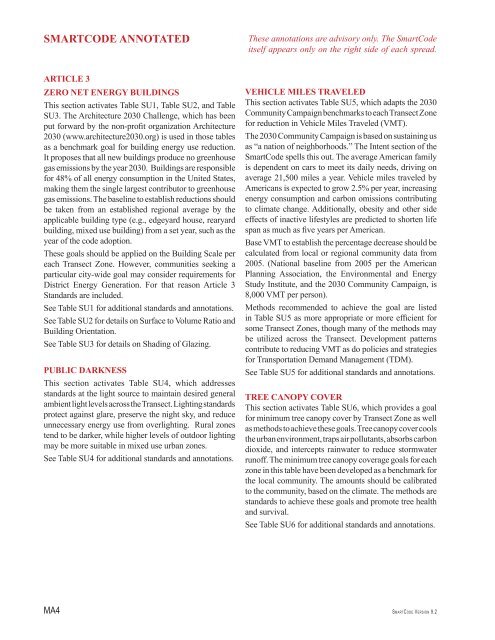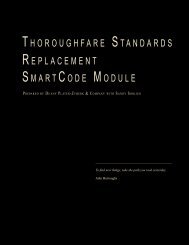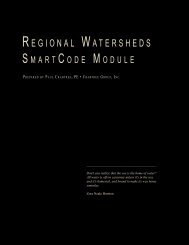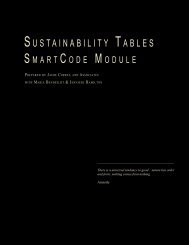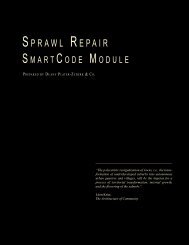U BANISM - Center for Applied Transect Studies
U BANISM - Center for Applied Transect Studies
U BANISM - Center for Applied Transect Studies
Create successful ePaper yourself
Turn your PDF publications into a flip-book with our unique Google optimized e-Paper software.
SMARTCODE ANNOTATED<br />
These annotations are advisory only. The SmartCode<br />
itself appears only on the right side of each spread.<br />
ARTICLE 3<br />
ZERO NET ENERGY BUILDINGS<br />
This section activates Table SU1, Table SU2, and Table<br />
SU3. The Architecture 2030 Challenge, which has been<br />
put <strong>for</strong>ward by the non-profit organization Architecture<br />
2030 (www.architecture2030.org) is used in those tables<br />
as a benchmark goal <strong>for</strong> building energy use reduction.<br />
It proposes that all new buildings produce no greenhouse<br />
gas emissions by the year 2030. Buildings are responsible<br />
<strong>for</strong> 48% of all energy consumption in the United States,<br />
making them the single largest contributor to greenhouse<br />
gas emissions. The baseline to establish reductions should<br />
be taken from an established regional average by the<br />
applicable building type (e.g., edgeyard house, rearyard<br />
building, mixed use building) from a set year, such as the<br />
year of the code adoption.<br />
These goals should be applied on the Building Scale per<br />
each <strong>Transect</strong> Zone. However, communities seeking a<br />
particular city-wide goal may consider requirements <strong>for</strong><br />
District Energy Generation. For that reason Article 3<br />
Standards are included.<br />
See Table SU1 <strong>for</strong> additional standards and annotations.<br />
See Table SU2 <strong>for</strong> details on Surface to Volume Ratio and<br />
Building Orientation.<br />
See Table SU3 <strong>for</strong> details on Shading of Glazing.<br />
PUBLIC DARKNESS<br />
This section activates Table SU4, which addresses<br />
standards at the light source to maintain desired general<br />
ambient light levels across the <strong>Transect</strong>. Lighting standards<br />
protect against glare, preserve the night sky, and reduce<br />
unnecessary energy use from overlighting. Rural zones<br />
tend to be darker, while higher levels of outdoor lighting<br />
may be more suitable in mixed use urban zones.<br />
See Table SU4 <strong>for</strong> additional standards and annotations.<br />
Vehicle Miles Traveled<br />
This section activates Table SU5, which adapts the 2030<br />
Community Campaign benchmarks to each <strong>Transect</strong> Zone<br />
<strong>for</strong> reduction in Vehicle Miles Traveled (VMT).<br />
The 2030 Community Campaign is based on sustaining us<br />
as “a nation of neighborhoods.” The Intent section of the<br />
SmartCode spells this out. The average American family<br />
is dependent on cars to meet its daily needs, driving on<br />
average 21,500 miles a year. Vehicle miles traveled by<br />
Americans is expected to grow 2.5% per year, increasing<br />
energy consumption and carbon omissions contributing<br />
to climate change. Additionally, obesity and other side<br />
effects of inactive lifestyles are predicted to shorten life<br />
span as much as five years per American.<br />
Base VMT to establish the percentage decrease should be<br />
calculated from local or regional community data from<br />
2005. (National baseline from 2005 per the American<br />
Planning Association, the Environmental and Energy<br />
Study Institute, and the 2030 Community Campaign, is<br />
8,000 VMT per person).<br />
Methods recommended to achieve the goal are listed<br />
in Table SU5 as more appropriate or more efficient <strong>for</strong><br />
some <strong>Transect</strong> Zones, though many of the methods may<br />
be utilized across the <strong>Transect</strong>. Development patterns<br />
contribute to reducing VMT as do policies and strategies<br />
<strong>for</strong> Transportation Demand Management (TDM).<br />
See Table SU5 <strong>for</strong> additional standards and annotations.<br />
TREE CANOPY COVER<br />
This section activates Table SU6, which provides a goal<br />
<strong>for</strong> minimum tree canopy cover by <strong>Transect</strong> Zone as well<br />
as methods to achieve these goals. Tree canopy cover cools<br />
the urban environment, traps air pollutants, absorbs carbon<br />
dioxide, and intercepts rainwater to reduce stormwater<br />
runoff. The minimum tree canopy coverage goals <strong>for</strong> each<br />
zone in this table have been developed as a benchmark <strong>for</strong><br />
the local community. The amounts should be calibrated<br />
to the community, based on the climate. The methods are<br />
standards to achieve these goals and promote tree health<br />
and survival.<br />
See Table SU6 <strong>for</strong> additional standards and annotations.<br />
MA4 S m a r t C o d e Ve r s i o n 9.2


